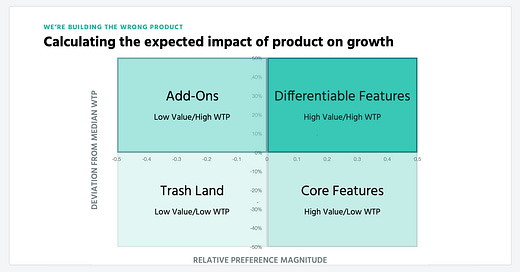SaaS Pricing is hard. PricingSaaS is your cheat code.
Monitor competitors, track real-time benchmarks, discover new strategies, and more.
My favorite feature packaging strategy
While working on SaaS pricing at ProfitWell, there was one slide in our kickoff deck that got clients more fired up than any other — the feature value matrix.
If you follow SaaS pricing, you’ve probably seen it:
To quickly explain:
→ The Y-axis gauges willingness to pay
→ The X-axis gauges relative preference
One cool thing about this matrix is that features tend to migrate from the top left to the bottom right over time — a feature that was once an add-on or differentiator eventually becomes table-stakes as the technology becomes more widely available.
For example — videoconferencing.
In 2015, Webex offered 25 meeting participants in its Premium plan. Today, Webex offers 100 meeting participants in its free plan.
One of the most powerful packaging strategies you can embrace is moving features through this progression more rapidly than competitors.
If you consistently push new features into lower tier plans, your customers will freaking love you, and competitors will struggle to keep up.
One budding opportunity for this strategy is Generative AI functionality, which is often packaged as an add-on today.
Pricing analysis 🔬
The most interesting pricing change I spotted this week came from Crunchbase.
I still thought of Crunchbase as a research tool, and had no idea they were dipping into sales enablement — which makes a ton of sense. The unique thing about Crunchbase is that much of their data is user-generated (e.g., a startup executive creates their own profile), meaning it has a high likelihood of accuracy.
This week, they started offering a 7-day free trial for premium contacts and data:
This feature allows users to go from company-level data to contact-level data. As a former salesperson, I can vouch that verified contact info for decision-makers is a cheat code. It’s the foundation of ZoomInfo’s multi-billion dollar market cap.
Overall, I really like how Crunchbase executed this move. Here’s why:
First, they chose free trial over a freemium plan.
Free trials are particularly effective for solutions that can leverage loss aversion. In this case, if a trial user builds a list of accurate contact info for their target accounts, they definitely won’t want to give up access when the trial ends.
Second, they put effective guardrails in place.
The risk of a free trial for a product like this is that users go on a “Free Trial Binge.”
Think about Netflix. There’s a reason they don’t offer free trials anymore. Users would sign up for a trial, binge the whole season of Stranger Things in a weekend, then move on without upgrading.
The same thing could happen to Crunchbase if they weren’t careful. A salesperson could sign up for a trial, find contact info for all of their target accounts, then move on. To prevent that, Crunchbase wisely put guardrails in place — limiting trial users to 10 verified contacts.
My only suggestion to make this trial more valuable to users is to extend the length. The goal of this product is to help salespeople connect with decision-makers at their target accounts, and 7 days is a tight turnaround to prove that value.
Since there’s already a limit on verified contacts, there’s little risk of revenue cannibalization by giving trial users more time to see value. Even 14 days would give users enough time to see responses trickle in from their target contacts.
PS. I used PricingSaaS to spot this pricing change. Get started for free and get instant alerts when competitors change their pricing page.
No links today — we had a sick toddler home this week and I didn’t get the chance to read or listen to anything 😂
Thanks for reading! If you enjoyed this post, consider liking it, subscribing, or sharing with a friend so Substack shows me some love.





